23 Email Metrics To Track For Better Sales Outreach
Do you know that conversions through email are 40% more than Facebook and Twitter? No wonder it is the go-to channel for sales outreach!
We could talk for days about the most critical elements of an effective outreach campaign: some common mistakes, a few shortcut formulas, different ways to pitch, and whatnot. But they are only impressive in the short term. But what matters the most is whether your efforts are moving in the right direction or not! Ans for that, you need to track the email metrics.
In this blog we are going to take a closer look at the top important email metrics that can affect your campaign.
Table Of Contents
- What Are Email Metrics?
- Importance Of Tracking Sales Email Metrics
- 23 Important Sales Email Metrics
- 1. Open Rate
- 2. Conversion Rate
- 3. Bounce rate
- 4. Click-Through Rate (CTR)
- 5. Return on Investment(ROI)
- 6. Opt-Out Rate
- 7. Email Sharing Rate
- 8. List Growth Rate
- 9. Spam Complaint Rate
- 10. Engagement Over Time
- 11. Mobile Open Rate
- 12. Mobile Click Rate
- 13. Domain Open Rate
- 14. Domain Click Rate
- 15. Revenue Per Email
- 16. Revenue Per Subscriber
- 17. Email Audience Trend
- 18. Active Audience Trend
- 19. Email Delivery Rate
- 20. Time Spent Viewing Email
- 21. Purchase Rate
- 22. Return On Ad Spend
- 23. Warm Reply Rate
- How To Find Out Which Metrics To Track?
- FAQs
What Are Email Metrics?
Email metrics also referred to as KPIs, provide you with a way to measure the success of your email campaign. Most often, the metrics that marketers have an interest in are of two types:
On-mail KPIs and off-mail KPIs.
On-mail KPIs
These are the metrics related to the user’s interaction with the email and include opens, clicks, unsubscribes, bounces and the like.
Off-mail KPIs
These are the email metrics to measure what begins in the email and goes elsewhere, such as a website or a blog. The metrics help determine the volume of the traffic the email channel generates, the conversion rate etc.
Importance Of Tracking Sales Email Metrics
Email marketing is a powerful strategy. Yet, if you do not track the sales email metrics, the benefits that arrive from it will never see the light of day. That’s why defining and tracking relevant metrics is critical for success. It provides you with a summary of interesting topics that engage with the audience. Email Analytics offers you the best recommendations for increasing conversion rates.
High-performing sales teams consistently measure the health of their business. You can improve sales email by tracking the essential metrics.
Here are the benefits of tracking cold email metrics,
1. Understanding how prospects engage with your email
With tracking of email metrics, you can find out how leads engage with your email content, and you can get a clear idea of whether your hard work in crafting emails is bearing fruit or not
2. Shape future campaigns
You can make informed decisions for your future email campaigns based on the metrics of your present campaign. They would help you find out what is working and what is not and the improvements you have to make in the different elements of your email. It would be easier to find out where the exact problem lies and work on those lines so that you can improve your upcoming campaign.
Tracking email engagement metrics can help you a lot because those who use 3rd party tools for this purpose have witnessed a 25% increase in ROI than businesses that don’t.
23 Important Sales Email Metrics
It is easy to get wrapped in any kind of metric. However, the 23 sales outreach metrics that will move the needle in your favor are,

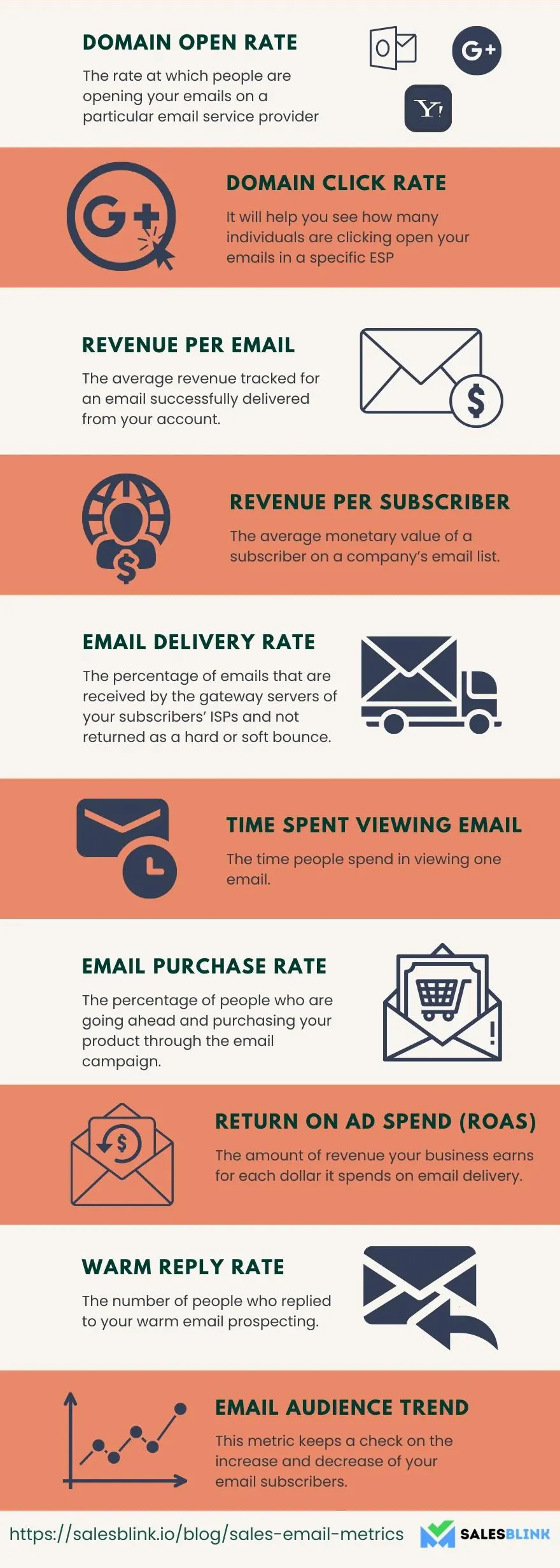
1. Open Rate
Open rate is the percentage of email receivers who opened your mail. The first sales email metric to track is your open rate.
Why does it matter?
It is an essential metric in email marketing because your emails are of no use if the recipients are not opening and reading them. According to a study, most email marketing campaigns have a little over 30%.
The main factor that draws more readers to your email is a compelling subject line. The average open rate should be between 15-20%. Give a try to SalesBlink’s Free Subject line generator.
TIP: This metric can sometimes be misleading, as open rate deals with the number of opened emails. But if the same receiver tries to open the email more than once, it is not included in the open rate. So try to give more value to the unique open rate.
Example
Here’s how to calculate it.
Number of Email Opens = 6
Number of Emails Sent = 100
Open rate = 6/100 x100% which is 6%
Therefore, the open rate is 6% in this case.
How to improve open rate?
The first thing that strikes the recipient’s eye is your email’s subject line; if you focus on improving it, the open rate will also increase. Try sending emails at different times and performing A/B tests to find out what works best.
2. Conversion Rate
The rate at which the user performs a particular action that could lead them to become a customer. The action can be to subscribe to an email newsletter, make a purchase, etc.
You can calculate the conversion rate by taking your number of conversions and dividing it by the number of interactions.
For Example:-
Conversions=9
Interactions=100
Conversion rate= 9/100=0.09
0.09*100=9%
This means 9% of people who visit your website convert.
Why does it matter?
The conversion rate helps to ascertain whether your investment is paying you off. Using it, you can determine how far your email has been successful. It also helps you understand whether the content of the email resonates with the audience or not.
How to improve conversion rate?
Ensure that the CTAs in your emails are clear so the recipient knows what to do next. The CTA text has to persuade the recipient to take the desired action.
3. Bounce Rate
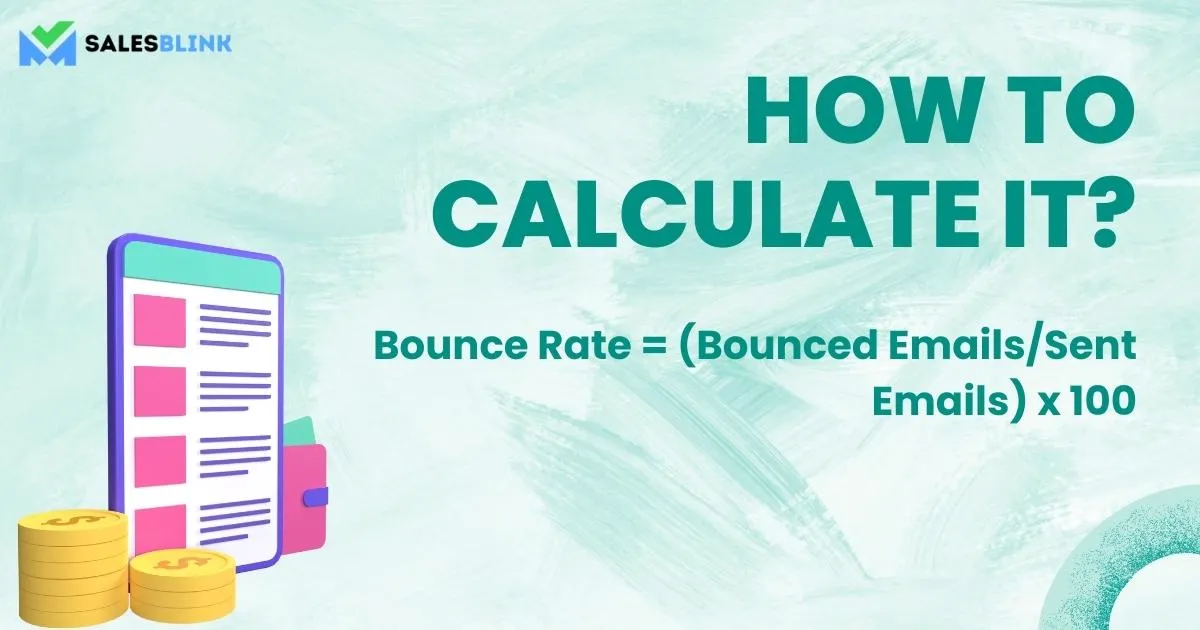
The bounce rate is the number of emails that have not reached the subscriber’s inbox and have probably bounced.
Emails can bounce due to many reasons:
- Subscriber’s mailbox is full.
- Subscriber’s email server was down at the time you tried to send an email.
- Invalid email address.
- Blocked IP address
Why does it matter?
When you have a high bounce rate, it is a cause of worry as it can make your emails get blocked by email service providers. Or worse, blacklist your IP address.
Bounce rate is a critical email metric that helps you to determine the deliverability of emails sent. Read a full guide on Cold email deliverability
Tracking your cold email bounce rate is very simple. You will get an email back every time one of your messages bounces. You can compile all such addresses and don’t use them for future campaigns.
As a rule of thumb, a bounce rate in the range of 26 to 40 percent is excellent. 41 to 55 percent is roughly average. 56 to 70 percent is higher than average but may not be cause for alarm depending on the website. Anything over 70 percent is disappointing for everything outside of blogs, news, events, etc.
How to calculate it?
Bounce Rate = (Bounced Emails/Sent Emails) x 100
Example
If number of bounced emails is 26 and the total number of emails sent is 100,
Bounce Rate = 26/100 x 100 = 26%
How to improve bounce rate?
Improve email deliverability by setting up the SPF, DMARC, and DKIM records. Also, make sure that you clean up mailing lists regularly to get rid of invalid email addresses.
4. Click-Through Rate (CTR)
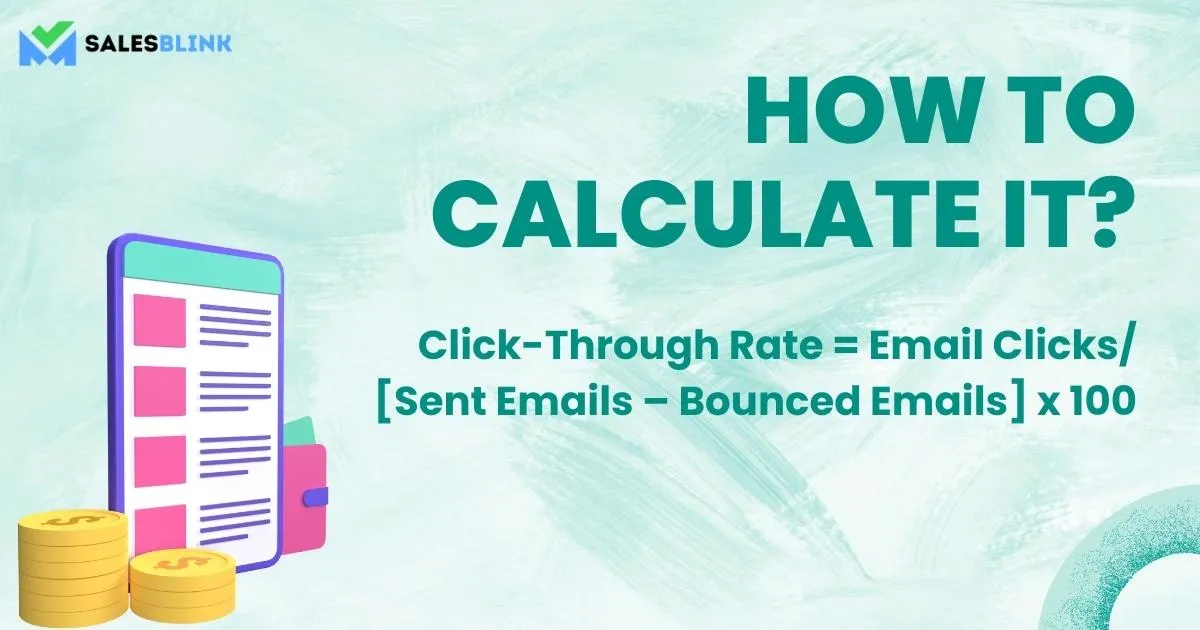
The click rate is the percentage of people who respond to your offer in the email by clicking the link to reach your sales page.
Why does it matter?
CTR is one of the most critical sales email metrics, and the sales team depends mainly on this to understand how each individual performs. It provides substantial insights into the interests that the individuals hold for your product or service.
You can take this ahead by understanding this metric deeply.
How to calculate it?
Click-Through Rate = Email Clicks/ [Sent Emails – Bounced Emails] x 100
Example
That is, if the number of email clicks is 40, sent emails are 100 and bounced emails are 2,
CTR = 40/ [100-2] x100 = 40.8%
How to improve CTR?
To make recipients click on the links in your email, you have to keep experimenting with different buttons and hyperlinking images.
5. Return on Investment(ROI)
ROI (Return on Investment) is one of the most important email tracking metrics. It shows you how much you earn compared to how much you invest.
Why does it matter?
It helps you to understand how successful the campaign has been in terms of cost-effectiveness.
As a part of a sales team, your email marketing campaign must produce a healthy return, and you need to be able to calculate it easily.
The simple method to calculate your overall ROI is by subtracting all the costs required to run this campaign from the campaign’s total revenue, then dividing the overall result by the initial cost and multiplying it by 100.
Email marketing is one of the cost-effective strategies as compared to other channels.
6. Opt-Out Rate
Opt-Out rate is the percentage of people who opt-out from your email list by unsubscribing it or sending it in spam.
The opt-out rate is:
(Unsubscribe numbers/Email delivered) * 100
You can expect a certain amount of people unsubscribing from your email list. It is pretty normal. However, most experts agree to the fact that anything below 0.05 is acceptable across all industries.
Example
10 unsubscribes for every 100 emails delivered take the unsubscribe rate to
10/100 x 100 = 10%
Why does it matter?
The significance of taking out the opt-out rate is to get insights on what’s going on and whether there is any particular thing that your audience does not like. The content might not be relevant, or maybe the sales pitch has been overstated.
How to reduce opt-out rate?
Try segmenting your email list to reach out to only those who find your emails relevant. Also, make sure that you personalize the email so there is a lesser chance of the recipient unsubscribing.
7. Email Sharing Rate
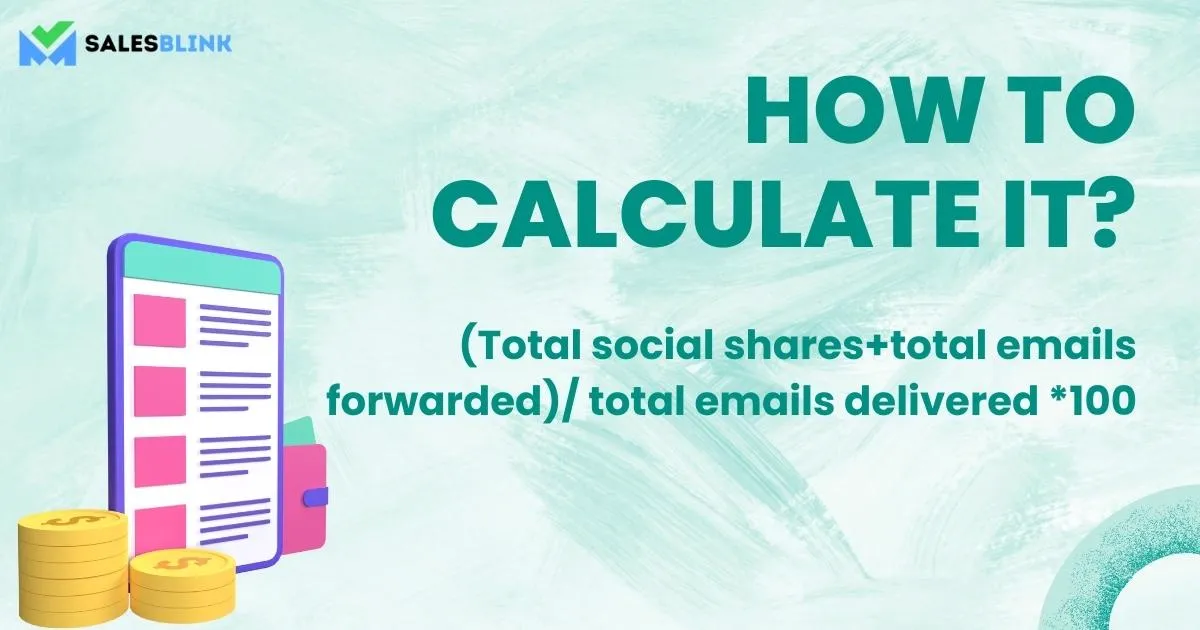
The rate at which your receivers shared your email on social media or forwarded your email. It helps to bring new leads and creates awareness of your brand.
How does it happen?
Whenever a recipient engages with your content and finds it useful, they will share it among their connections. It helps to build a new chain of leads.
How to calculate?
(Total social shares+total emails forwarded)/ total emails delivered *100.
Example
Total shares on social media = 25
Total emails forwarded = 25
No of emails sent = 100
Therefore, email sharing rate = 50/100 x 100 = 50%
Why does it matter?
Email sharing rate is a vital email metric to measure, as it helps you know what type of content is gaining attention and generating leads. You can further tap into this type of content for upcoming email marketing campaigns. The best way to understand what the reader wants.
How to increase email sharing rate?
If you provide useful and relevant content to the email recipient in a presentable manner, they are more likely to share or forward them.
8. List Growth Rate
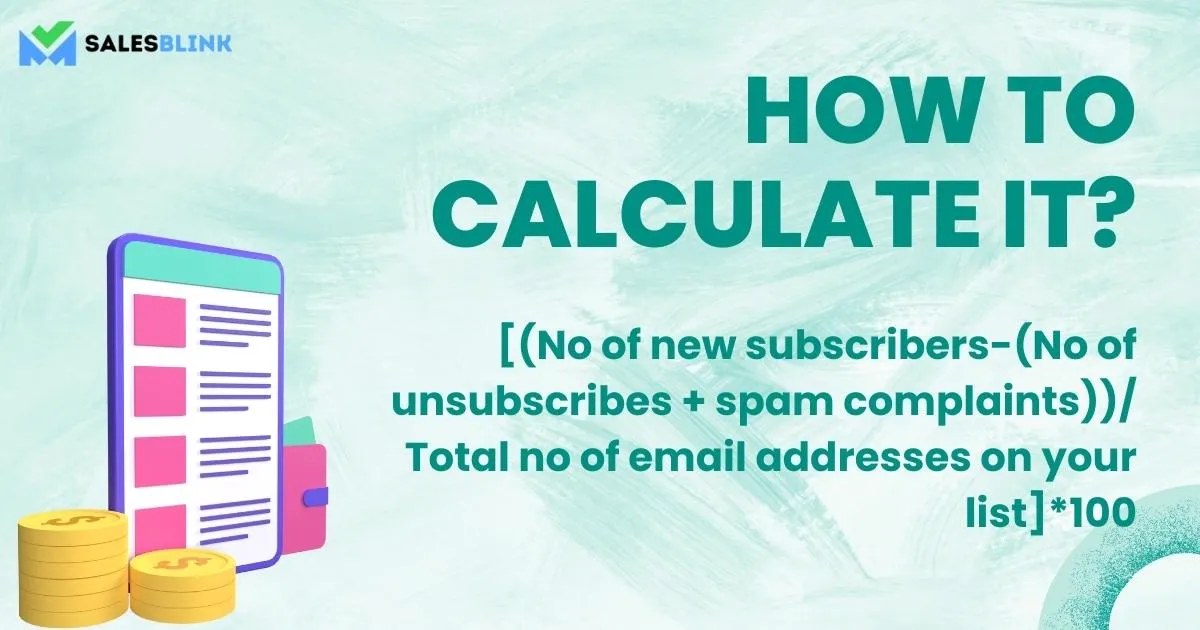
As the term clearly says, it is the rate at which your subscriber list is growing. May it is any business, the primary thing that we look at is whether the business is growing as time passes by or not.
The same is the case here. Are we able to expand our audience and create more awareness for our brand?
How to calculate?
[(No of new subscribers-(No of unsubscribes + spam complaints))/ Total no of email addresses on your list]*100
Example
(300 new subscribers – 100 unsubscribes and email/spam complaints) ÷ 10,000 email addresses on the list x 100 = 3% list growth rate
Why does it matter?
It would be best if you kept a tab on your growth rate numbers. With this, you can measure your new subscribers’ growth and have an idea of whether you are going in the right direction or not.
How to increase list growth rate?
Make sure that you keep the subscribers engaged so that they don’t unsubscribe from the list.
9. Spam Complaint Rate
If email service providers mark your emails as spam, it can get discouraging. You should pay attention to spam complaints because your ESP might penalize you and even block your account if the rate is too high.
Why does it matter?
Though the email service provider will keep a count of the spam complaints, you have to keep an eye on the number to make sure that there is no technical problem and the content of your emails is as per your standards.
How to decrease spam complaint rate?
Ensure that you don’t purchase email lists from 3rd parties and remove invalid addresses from your list periodically. Aso, personalize your messages so that the recipient is likely to complain.
10. Engagement Over Time
When you track engagement time, it will help you find out the right time to send messages in the day. It is one of the critical email metrics to track for sales.
Though automation will help you send emails based on a trigger or the customer’s behaviour, tracking engagement will help you get results. It will fetch you the maximum open rates and click rates.
Why does it matter?
There are email service providers that automate engagement tracking, but it is good to track it on your own too. You can find out when you should shoot our emails to prospects to get maximum benefits.
11. Mobile Open Rate
The mobile open rate is the same as the usual open rate, but the only difference is that this metric applies to mobile devices such as smartphones and tablets.
The desktop open rates are more during the weekday as people are on their 9-5 jobs. On the other hand, mobile rates are higher on weekends when people decide to chill out with their mobile devices.
Why does it matter?
This metric helps in finding out how many people like to open your emails on mobile devices so that you can optimize the email accordingly.
How to increase mobile open rate?
Needless to say, when you optimize your email subject lines for mobile devices, you will see a surge in open rates.
12. Mobile Click Rate
Just like the mobile open rate, this metric is also for mobile devices. You get to know the email click rates on mobile devices like tablets and smartphones.
When compared to desktop click rates, mobile click rates are lower. You can operate work on multiple windows and browse easily on a desktop than when on the tab or phone.
Why does it matter?
It helps in understanding the click rate on mobile devices. That would help you know how many people are engaging with your email through tabs and smartphones.
How to increase mobile click rate?
If the mobile click rate is low, you can start working on making the interface more mobile-friendly.
13. Domain Open Rate
The domain open rate is an essential sales email metric as it ensures the success of the email campaign. This rate helps you see how many people are opening your emails on a particular email service provider(the value will be in percentage).
Why does it matter?
It will help you understand whether your emails are landing in the spam folder of a particular ESP. You can accordingly take the necessary measures.
14. Domain Click Rate
The domain click rate will help you see how many individuals are clicking open your emails in a specific ESP.
Why does it matter?
When you have this metric in front of you, you can compare one provider’s click rate with that of the other. It will help you find out whether there is a problem with a particular provider’s spam policy.
You need to find the average and make the comparison.
15. Revenue Per Email
To know the overall return on investment, there is the ROI metric; What about measuring each email’s performance?
Why does it matter?
Revenue per email is a metric that helps you find out which email is doing the best and which are the ones that are bringing the total ROI down.
16. Revenue Per Subscriber
To take an in-depth look at the ROI, you can calculate the revenue per subscriber. It is different from the revenue per email metric. Revenue per subscriber will help you find out which demographic is helping you get better revenue. It will enable you to focus on demographics that are beneficial for your business.
Why does it matter?
You can start concentrating on the ones that are profitable and ignore the ones that are not. It will help you rebuild your strategy. After all, you are working so hard to see positive results at the end of the day, aren’t you?
17. Email Audience Trend
Gaining and losing subscribers is quite natural. When you come to know that the number is declining at an earlier stage, you can foresee the outcome and prevent major financial issues shortly.
Why does it matter?
You can take action and try to find out why your subscribers are leaving you and what should you do from your end.
Early action will prevent your business from facing problems at a later stage. It is always better to contain the damage at an early stage.
18. Active Audience Trend
It is essential to check the increase or decline of your active audience. The active audience refers to those who engage with your emails and are the ones behind bringing the maximum revenue.
It directly means that you have to communicate the most with them.
Why does it matter?
In case there is a problem, it would be better if you can detect them early. It would prevent your active audience from reducing in number.
You can track this sales email metric using the formula below:
(New active subscribers) – (Subscriber changing to lapsing)/active audience) x 100
19. Email Delivery Rate
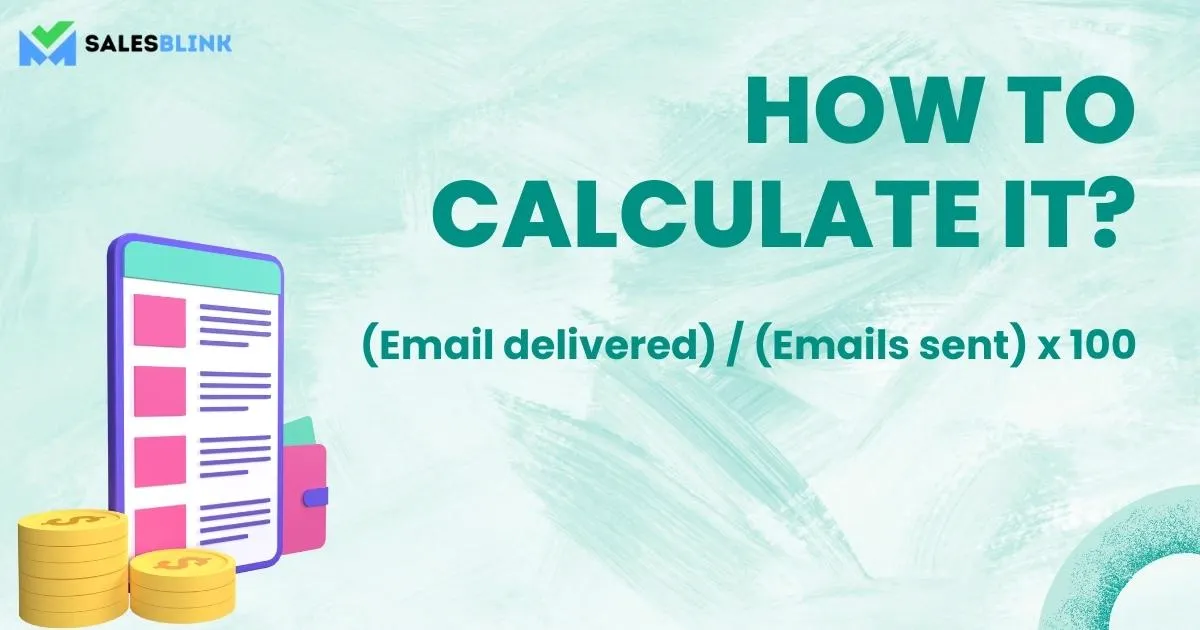
It is often the delivery rate of an email that you measure first after sending an email. It simply means that the server of the recipient accepted it. When there are deliverability issues, there is a drop in the delivery rate.
Why does it matter?
With a clean database, you will be able to get a 99% or more delivery rate. You can start worrying when it falls below 97%. You have to start by finding out from where you are getting the email addresses.
A higher delivery rate is nothing to be proud of because your email can end up in the junk or spam folder instead of hitting the inbox. It is of no use to you as the recipient won’t come to know about it, and you would lose the very purpose of emailing.
How to calculate?
Here is how this email metric is calculated:
(Email delivered) / (Emails sent) x 100
Example
If 90 emails reach the recipient and total number of emails sent are 100,
Email delivery rate = (90/100) x 100 = 90%
How to increase email delivery rate?
Send emails only to valid addresses by verifying your list periodically. Also, make sure you are in the good books of the ESP i.e. your sender reputation is good.
20. Time Spent Viewing Email
Some tools help in finding out the time people spend viewing one email.
Why does it matter?
It is helpful to find out whether the content you are providing is important to customers or not. Are they able to find what they are searching for?
When a click short follows the reading time, it indicates that the prospect could find what he was looking for.
Contrarily, when a prospect takes too much time to read and doesn’t click, it simply means that he has not found what he was looking for. It may not be a very critical metric, but you must have a watch over it.
How to increase time spent on email?
Provide relevant information to the prospect that adds value to keep recipients engaged.
21. Purchase Rate
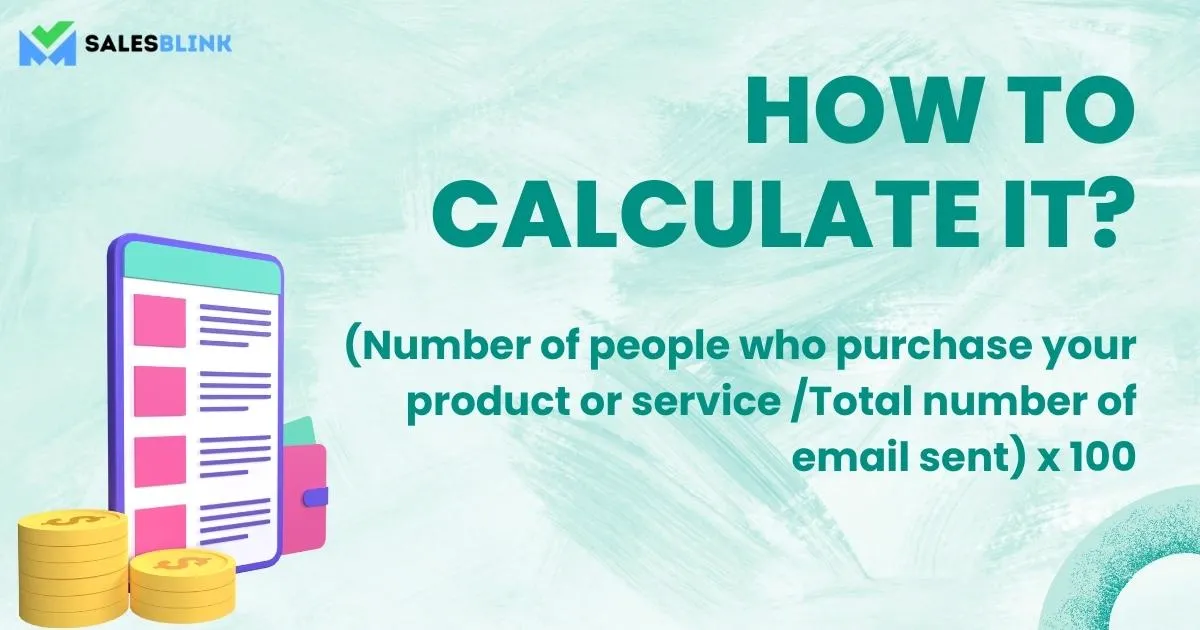
The purchase rate is different from the conversion rate. It measures the percentage of people going ahead and purchasing your product or service through the email campaign.
How to calculate it?
(Number of people who purchase your product or service /Total number of email sent) x 100
Example
If 10 people make a purchase and the total number of email sent are 100,
Purchase rate = 10/100 x 100 = 10%
Why does it matter?
It helps find out how many recipients are making a purchase straight away from the emails received.
How to increase purchase rate?
Make the email so persuasive that the recipient goes in for a purchase. It depends on how you present it.
22. Return On Ad Spend
People often categorize emails as ‘free’ because they don’t take the other costs involved into consideration. That includes the cost of creating and maintaining an email list. You should also consider the time that the team members spend in creating the email campaign’s content.
Why does it matter?
In addition to that, you have to pay for the platform you use. Therefore, you must take a look at the profit and loss involved. Are you getting enough returns on the amount you are spending or not?
23. Warm Reply Rate
The warm reply rate is a metric worth paying attention to. When you see open rates of more than 40%, you can get happy, but that doesn’t generate revenue directly.
Why does it matter?
You should ask yourself whether or not you are getting the leads you want from the campaign. You can aim for a warm reply rate of 5-6% on cold emails.
How To Find Out Which Metrics To Track?
The clear-cut answer to that would be to consider your organization’s goals.
What organization A wants to achieve through the email campaign is not the same as what organization B wants. The goal of the same company can also change with time. Therefore, you have to understand what you want to achieve from your email campaigns right from the start.
Here are the possible goals,
1. Find subscribers who don’t engage with your emails
You can find out those who don’t engage with your emails with email metrics. It is essential to do away with such subscribers because your email deliverability can be affected if you continue to send emails to such individuals.
2. Convert leads to customers
For converting leads into paying customers with your email campaign, the emails must have content related to the solution you are offering with CTAs like ‘Get a free demo’, ‘Start a free trial’, and so on. When the goal is to convert leads, it is essential to pay attention to the conversion rate closely.
So, the stats to track for sales has a link with the goal you want to achieve.
Start Tracking Your Emails To Gauge Your Campaign
Every sales team is bound to a goal that they have to achieve. Dig deeper into your own sales prospecting efforts by setting the right metrics according to your goal. It helps you to understand and move in the right direction.
However, the sales email metrics will guide you with purposeful action, highlighting trends and making the team more efficient over time. Track these sales email metrics regularly, regardless of your process. Try using the right email tracking software for this.
With these email engagement metrics, you will get an idea of how well you are progressing. In case there is a problem, you can take the necessary measures to change your strategy or work on it again. The email measurement metrics will go a long way in preventing losses and helping your business reach where you want it to.
Use our suggestions in this post and watch your next outreach campaign be a success.
FAQs
The rate at which the user performs a particular action that could lead them to become a customer. The action can be to subscribe to an email newsletter, make a purchase, etc.
Email metrics also referred to as KPIs, provide you with a way to measure the success of your email campaign. Most often, the metrics that marketers have an interest in are of two types: on-mail KPIs and off-mail KPIs.
Open rate is the percentage of email recipients who opened your mail. The first sales email metric to track is your open rate. It is an essential metric as your emails are futile if recipients don’t open them.







